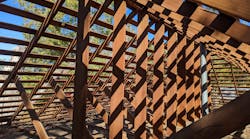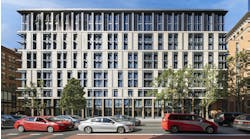Let’s take a look inside our building's emissions problem.
According to the UN, every five days the world adds enough new buildings to total the size of Paris, and then we fill those buildings with oh-so-many things.
We extract raw materials, transform them into new products, use them until we no longer need them. And then, at the end of their useful life to us, we discard these products as waste.
This vicious take-make-waste cycle has made the built environment one of the largest emitters of greenhouse gasses in the world. The industry as a whole is responsible for about 42% of annual global CO2 emissions, and over two-thirds of those emissions are attributed to the manufacturing, extraction, transportation, maintenance, and disposal of building materials and products.
To combat this, the world will have no choice but to move towards a circular economy in the buildings sector—where the waste outputs of one organization become the inputs of another. As it stands today, however, we are heading in the wrong direction. The world is about 17% less circular, currently 7.2% down from 8.6% last year, than it was just five years ago, according to Deloitte. This means that of all the materials used in our economy across the world, only 7.2% of them are secondary, or recycled.
Facilities professionals have a critical role to play in reversing this trend, and they're going to need all the help they can get. Can historic preservation—an endeavor that seeks to preserve, conserve and protect buildings, objects, landscapes and local traditions—be an unlikely ally in the industry's pursuit of circularity?
With Hybrid Work, Facility Managers Are at a Crossroads When It Comes to Sustainability
They must tear down spaces as quickly and economically as possible, plan for hybrid work with fewer workstations, all while being mindful of company sustainability goals to reduce waste and carbon emissions.
In fact, at IFMA World Workplace this year in Denver, CBRE identified that the biggest trends in facilities management (FM) are cost certainty, operational efficiency, sustainability, data-at-scale and balancing priorities.
All of these needs are usually at odds, too, made more difficult by a lack of advance notice, changing space planning and uncertainty around what it takes to keep furniture and other unwanted-but-still-valuable items out of landfill.
How do I find time to find the next use in the community? Can somebody get rid of these items quickly and sustainably? What am I to do with the 400,000-square-foot storage of outdated chairs?
These questions are the norm these days, and it's not inconceivable to say that facilities managers rarely think about interior building materials and their effect on global warming and climate change, or even historic preservation. But this needs to change moving forward.
The Role of FM in Historic Preservation
During a recent presentation given by CBRE at IFMA World Workplace 2023, It was discussed how every item detail under a facilities manager’s purview can be a huge risk for the business, employees and anyone else who comes into a physical space, which is why the first step in CBRE’s asset excellence program is Know and Quantify.
This is the hallmark of historic preservation, too. Historic preservation is about documenting and sharing information about existing buildings, their materials, and their importance and connection to surrounding communities—both tangible and intangible.
In fact, the Historic Design Guidelines adopted by the City of San Antonio Office of Historic Preservation for landmarks and historic districts encourage “giving a new use for, and maximizing the retention of, distinctive materials.” In the past, a facility manager might have thought of historic preservation in the following ways:
- Inspecting a building for deterioration or unique historic features
- Reducing the energy consumption associated with large and older buildings
- Complying with regulatory and statutory historic preservation laws
While all of these duties remain relevant, protecting the interiors of historic buildings and the materials that define them is equally important but often misunderstood. It can often be an afterthought, too, even if well-intentioned facility managers do everything in their power to store interesting items hoping for a next, best use.
Historic Preservation is About Preserving Embodied Carbon, Too
The U.S. Green Building Council (USGBC) recently released the draft language for the newest version of the LEED standard for existing buildings, LEED v5. One of the biggest updates is that it “provides simple, clear steps for delivering ultra-low-carbon buildings” while requiring “social impact assessment” as a prerequisite for certification.
Carbon dioxide emissions from raw material sourcing, supplier processing and manufacturing—often referred to as embodied carbon—is unsurprisingly a highlight of the new LEED v5 standards, and a hot topic in the federal government.
Embodied carbon reduction strategies are now laser focused on reuse, meaning it’s no longer acceptable for designers to simply think about purchasing low-carbon materials—they will need to think about how existing building products make up the next build or remodel.
With office occupancy hovering at about 50% across the country, and vacancy rates at levels we haven’t seen since over a decade ago, a facilities manager now can play a pivotal role in opening up their surplus inventory to a host of organizational and external demand recipients—in particular, local designers, project managers and space planners who want to build new or retrofit spaces without creating more waste.
The City of San Antonio is actively testing this concept through their deconstruction ordinance and Material Innovation Center: inventorying reclaimed materials that are donated to the facility and making them both visible and available to affordable housing and trades training efforts. An analogy drives this effort: like an organ donor, a structure may have reached the end of its life, but its parts and pieces could help extend the lives of other structures.
And every time a building is rehabilitated with important resources reused, trade and skilled laborers become employed. This creates jobs and puts more money into our local economy. This is historic preservation at its finest—and it’s the facilities teams acting as one of the last lines of defense before the landfill.


